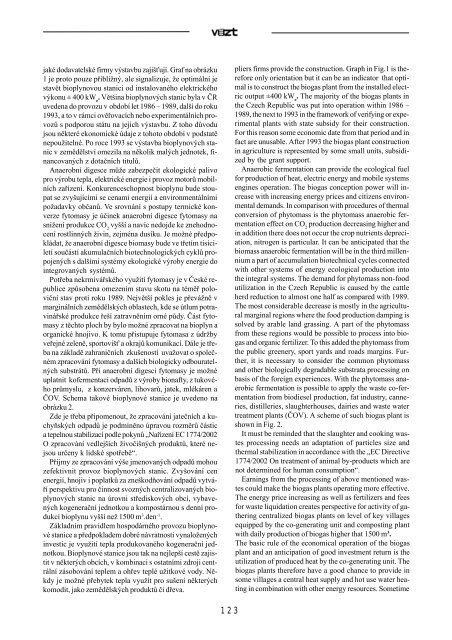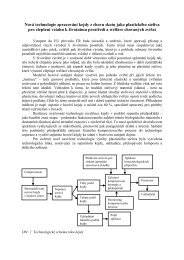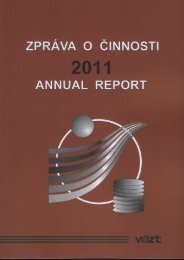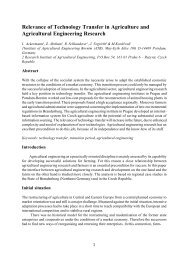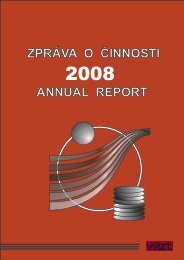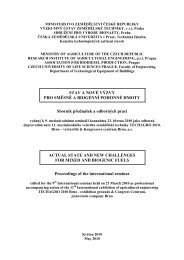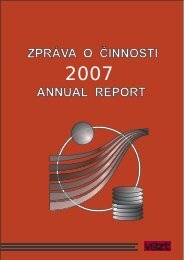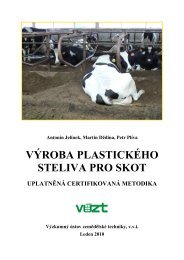Zpráva o ÄÂinnosti v roce 2006 (10MB) - SVT
Zpráva o ÄÂinnosti v roce 2006 (10MB) - SVT
Zpráva o ÄÂinnosti v roce 2006 (10MB) - SVT
Create successful ePaper yourself
Turn your PDF publications into a flip-book with our unique Google optimized e-Paper software.
jaké dodavatelské firmy výstavbu zajiš ují. Graf na obrázku<br />
1 je proto pouze pøibližný, ale signalizuje, že optimální je<br />
stavìt bioplynovou stanici od instalovaného elektrického<br />
výkonu ± 400 kW e<br />
. Vìtšina bioplynových stanic byla v ÈR<br />
uvedena do provozu v období let 1986 – 1989, další do roku<br />
1993, a to v rámci ovìøovacích nebo experimentálních provozù<br />
s podporou státu na jejich výstavbu. Z toho dùvodu<br />
jsou nìkteré ekonomické údaje z tohoto období v podstatì<br />
nepoužitelné. Po <strong>roce</strong> 1993 se výstavba bioplynových stanic<br />
v zemìdìlství omezila na nìkolik malých jednotek, financovaných<br />
z dotaèních titulù.<br />
Anaerobní digesce mùže zabezpeèit ekologické palivo<br />
pro výrobu tepla, elektrické energie i provoz motorù mobilních<br />
zaøízení. Konkurenceschopnost bioplynu bude stoupat<br />
se zvyšujícími se cenami energií a environmentálními<br />
požadavky obèanù. Ve srovnání s postupy termické konverze<br />
fytomasy je úèinek anaerobní digesce fytomasy na<br />
snížení produkce CO 2<br />
vyšší a navíc nedojde ke znehodnocení<br />
rostlinných živin, zejména dusíku. Je možné pøedpokládat,<br />
že anaerobní digesce biomasy bude ve tøetím tisíciletí<br />
souèástí akumulaèních biotechnologických cyklù propojených<br />
s dalšími systémy ekologické výroby energie do<br />
integrovaných systémù.<br />
Potøeba nekrmiváøského využití fytomasy je v Èeské republice<br />
zpùsobena omezením stavu skotu na témìø polovièní<br />
stav proti roku 1989. Nejvìtší pokles je pøevážnì v<br />
marginálních zemìdìlských oblastech, kde se útlum potravináøské<br />
produkce øeší zatravnìním orné pùdy. Èást fytomasy<br />
z tìchto ploch by bylo možné zpracovat na bioplyn a<br />
organické hnojivo. K tomu pøistupuje fytomasa z údržby<br />
veøejné zelenì, sportoviš a okrajù komunikací. Dále je tøeba<br />
na základì zahranièních zkušeností uvažovat o spoleèném<br />
zpracování fytomasy a dalších biologicky odbouratelných<br />
substrátù. Pøi anaerobní digesci fytomasy je možné<br />
uplatnit kofermentaci odpadù z výroby bionafty, z tukového<br />
prùmyslu, z konzerváren, lihovarù, jatek, mlékáren a<br />
ÈOV. Schema takové bioplynové stanice je uvedeno na<br />
obrázku 2.<br />
Zde je tøeba pøipomenout, že zpracování jateèních a kuchyòských<br />
odpadù je podmínìno úpravou rozmìrù èástic<br />
a tepelnou stabilizací podle pokynù „Naøízení EC 1774/2002<br />
O zpracování vedlejších živoèišných produktù, které nejsou<br />
urèeny k lidské spotøebì“.<br />
Pøíjmy ze zpracování výše jmenovaných odpadù mohou<br />
zefektivnit provoz bioplynových stanic. Zvyšování cen<br />
energií, hnojiv i poplatkù za zneškodòování odpadù vytváøí<br />
perspektivu pro èinnost svozných centralizovaných bioplynových<br />
stanic na úrovni støediskových obcí, vybavených<br />
kogeneraèní jednotkou a kompostárnou s denní produkcí<br />
bioplynu vyšší než 1500 m 3 .den -1 .<br />
Základním pravidlem hospodárného provozu bioplynové<br />
stanice a pøedpokladem dobré návratnosti vynaložených<br />
investic je využití tepla produkovaného kogeneraèní jednotkou.<br />
Bioplynové stanice jsou tak na nejlepší cestì zajistit<br />
v nìkterých obcích, v kombinaci s ostatními zdroji centrální<br />
zásobování teplem a ohøev teplé užitkové vody. Nìkdy<br />
je možné pøebytek tepla využít pro sušení nìkterých<br />
komodit, jako zemìdìlských produktù èi døeva.<br />
pliers firms provide the construction. Graph in Fig.1 is therefore<br />
only orientation but it can be an indicator that optimal<br />
is to construct the biogas plant from the installed electric<br />
output ±400 kW e<br />
. The majority of the biogas plants in<br />
the Czech Republic was put into operation within 1986 –<br />
1989, the next to 1993 in the framework of verifying or experimental<br />
plants with state subsidy for their construction.<br />
For this reason some economic date from that period and in<br />
fact are unusable. After 1993 the biogas plant construction<br />
in agriculture is represented by some small units, subsidized<br />
by the grant support.<br />
Anaerobic fermentation can provide the ecological fuel<br />
for production of heat, electric energy and mobile systems<br />
engines operation. The biogas conception power will increase<br />
with increasing energy prices and citizens environmental<br />
demands. In comparison with p<strong>roce</strong>dures of thermal<br />
conversion of phytomass is the phytomass anaerobic fermentation<br />
effect on CO 2<br />
production decreasing higher and<br />
in addition there does not occur the crop nutrients depreciation,<br />
nitrogen is particular. It can be anticipated that the<br />
biomass anaerobic fermentation will be in the third millennium<br />
a part of accumulation biotechnical cycles connected<br />
with other systems of energy ecological production into<br />
the integral systems. The demand for phytomass non-food<br />
utilization in the Czech Republic is caused by the cattle<br />
herd reduction to almost one half as compared with 1989.<br />
The most considerable decrease is mostly in the agricultural<br />
marginal regions where the food production damping is<br />
solved by arable land grassing. A part of the phytomass<br />
from these regions would be possible to p<strong>roce</strong>ss into biogas<br />
and organic fertilizer. To this added the phytomass from<br />
the public greenery, sport yards and roads margins. Further,<br />
it is necessary to consider the common phytomass<br />
and other biologically degradable substrata p<strong>roce</strong>ssing on<br />
basis of the foreign experiences. With the phytomass anaerobic<br />
fermentation is possible to apply the waste co-fermentation<br />
from biodiesel production, fat industry, canneries,<br />
distilleries, slaughterhouses, dairies and waste water<br />
treatment plants (ÈOV). A scheme of such biogas plant is<br />
shown in Fig. 2.<br />
It must be reminded that the slaughter and cooking wastes<br />
p<strong>roce</strong>ssing needs an adaptation of particles size and<br />
thermal stabilization in accordance with the „EC Directive<br />
1774/2002 On treatment of animal by-products which are<br />
not determined for human consumption“.<br />
Earnings from the p<strong>roce</strong>ssing of above mentioned wastes<br />
could make the biogas plants operating more effective.<br />
The energy price increasing as well as fertilizers and fees<br />
for waste liquidation creates perspective for activity of gathering<br />
centralized biogas plants on level of key villages<br />
equipped by the co-generating unit and composting plant<br />
with daily production of biogas higher that 1500 m 3 .<br />
The basic rule of the economical operation of the biogas<br />
plant and an anticipation of good investment return is the<br />
utilization of produced heat by the co-generating unit. The<br />
biogas plants therefore have a good chance to provide in<br />
some villages a central heat supply and hot use water heating<br />
in combination with other energy resources. Sometime<br />
123


